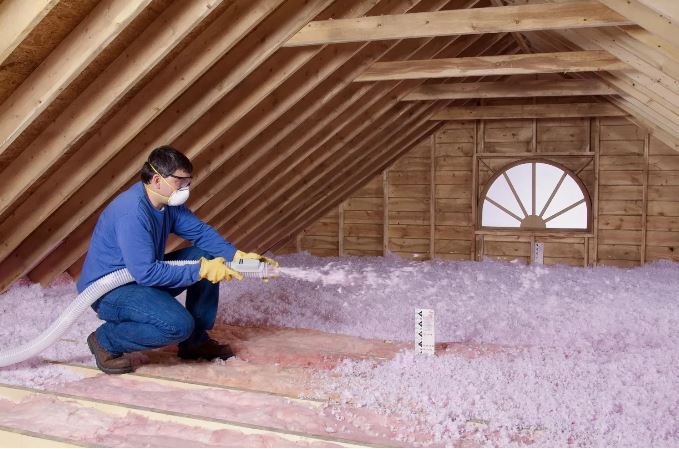A blown-in insulation contractor plays a crucial role in enhancing energy efficiency and comfort in homes and buildings. They specialize in applying blown-in fiberglass insulation, which offers significant benefits in terms of thermal performance and ease of installation. This guide explores the responsibilities and benefits of hiring a blown-in insulation contractor, shedding light on what to expect and how their services can improve your property.
The Essential Functions of a Blown-In Insulation Contractor
A blown-in insulation contractor is an expert in installing blown-in fiberglass insulation, a popular choice for its effectiveness in insulating various areas of a building. Here’s a detailed look at their core responsibilities:
Assessing Insulation Needs
The first step for any skilled blown-in insulation contractor is to assess the insulation needs of a property. This involves:
- Evaluating Current Insulation: They will examine the existing insulation levels and identify areas where insulation is lacking or deteriorating.
- Identifying Problem Areas: Key areas such as attics, walls, and crawl spaces are scrutinized for gaps or inefficiencies.
- Recommending Solutions: Based on their assessment, they recommend the appropriate type and amount of blown-in fiberglass insulation.
Preparing the Installation Area
Proper preparation is vital for a successful insulation installation. Contractors typically:
- Clear the Work Area: They ensure the installation site is free of debris and obstacles.
- Seal Air Leaks: Before installing new insulation, they may seal any air leaks to prevent drafts and improve energy efficiency.
- Protect Surroundings: Measures are taken to protect the property from insulation dust and debris.
Installing Blown-In Fiberglass Insulation
The installation of blown-in fiberglass insulation is a precise process involving:
- Setting Up Equipment: Contractors use specialized machinery to blow the insulation material into the desired spaces.
- Achieving Proper Coverage: They ensure even distribution and adequate coverage to maximize thermal efficiency.
- Testing for Effectiveness: After installation, they may test the insulation to ensure it meets the required standards.
Ensuring Quality and Compliance
A professional contractor ensures that all installations comply with industry standards and local building codes. This includes:
- Checking Insulation Thickness: They verify that the insulation meets recommended thickness levels for optimal performance.
- Ensuring Proper Ventilation: Proper ventilation is crucial to prevent moisture buildup, which can lead to mold and other issues.
- Providing Post-Installation Advice: Contractors offer guidance on maintaining and monitoring the insulation to ensure long-term effectiveness.
Why Choose Blown-In Fiberglass Insulation?
Blown-in fiberglass insulation is a popular choice for many reasons. Here’s why it might be the right option for your property:
Energy Efficiency
Blown-in fiberglass insulation is highly effective at reducing heat transfer, helping to maintain consistent indoor temperatures and reduce energy bills.
Quick and Efficient Installation
The installation process for blown-in fiberglass insulation is relatively quick compared to other insulation methods. This minimizes disruption to your daily life.
Versatility
This type of insulation can be applied in various spaces, including hard-to-reach areas such as attics and wall cavities. Its flexibility makes it suitable for both new constructions and retrofits.
Improved Comfort
By reducing drafts and heat loss, blown-in fiberglass insulation enhances overall comfort within the building, creating a more stable and enjoyable living environment.
What to Expect During the Installation Process
Understanding the installation process helps manage expectations and ensures a smooth experience with your blown-in insulation contractor. Here’s a step-by-step overview:
Initial Consultation
The process typically begins with an initial consultation where the contractor assesses your needs, discusses options, and provides a quote. This stage is crucial for understanding the scope of work and setting realistic expectations.
Preparation and Setup
Before installation, the contractor prepares the site, ensuring it is ready for the insulation process. This includes clearing the area and sealing any gaps.
Insulation Application
The contractor uses specialized equipment to blow the fiberglass insulation into the designated areas. This step requires precision to ensure even coverage and effectiveness.
Final Inspection and Clean-Up
After installation, the contractor conducts a final inspection to verify that the insulation meets all standards and performs a thorough clean-up to remove any debris from the site.
Post-Installation Support
A reliable contractor provides post-installation support, including advice on maintenance and any follow-up inspections if needed.
Frequently Asked Questions
What are the benefits of blown-in fiberglass insulation?
Blown-in fiberglass insulation offers several benefits, including enhanced energy efficiency, quick installation, versatility for various applications, and improved comfort.
How long does the installation process take?
The duration of the installation process can vary depending on the size of the property and the complexity of the job. However, it is generally completed within a few hours to a day.
Is blown-in insulation suitable for existing homes?
Yes, blown-in insulation is ideal for existing homes, especially in areas like attics and wall cavities where other types of insulation may be difficult to install.
How do I know if my insulation needs to be replaced?
Signs that your insulation may need replacement include noticeable drafts, inconsistent indoor temperatures, and high energy bills. A professional contractor can perform an assessment to determine if replacement is necessary.
What should I look for in a blown-in insulation contractor?
When choosing a contractor, look for experience, positive customer reviews, proper licensing and insurance, and a clear understanding of local building codes and standards.
Conclusion
A blown-in insulation contractor plays a vital role in enhancing the energy efficiency and comfort of your property. By understanding their responsibilities and the benefits of blown-in fiberglass insulation, you can make an informed decision about your insulation needs. Whether you are in Milam County or surrounding areas such as Bastrop County, Burleson County, Lee County, Travis County, Washington County, or Williamson County, Texas, the right contractor can ensure that your insulation project is completed effectively and efficiently. For more information or to schedule a consultation, contact H&H Spray Foam & Drywall at (979) 218-6941.


